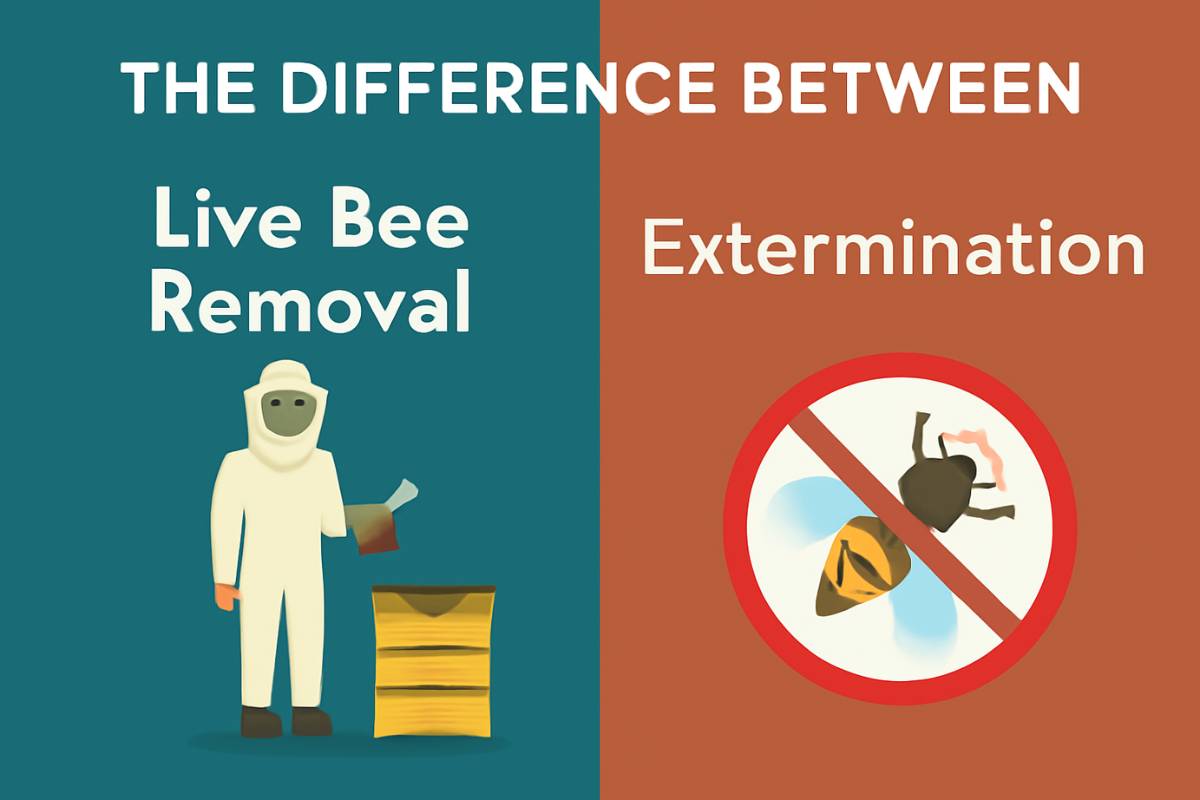Bees are essential to our environment, playing a critical role in pollination and maintaining healthy ecosystems. However, when they decide to set up their colonies near human dwellings, they can quickly become a problem. When faced with a bee infestation, many homeowners face a tough decision: Should they opt for live bee removal or bee extermination? Both methods have their advantages and disadvantages, and the right choice depends on several factors, including the bee’s location, the severity of the infestation, and your environmental concerns. This blog will explore the key differences between bee removal and extermination, providing insight into both options and guiding you toward the most suitable choice for your situation.
What is Live Bee Removal?
Bee removal is the process of safely relocating a bee colony to a new, more suitable location without harming the bees. Live bee removal is the preferred choice for many beekeepers and bee specialists, as it preserves the bees and ensures their crucial role in pollination continues. This process involves humanely removing the bees from their current location and transferring them to a hive, where they can continue their natural activities.
Why Choose Live Bee Removal?
Choosing humane bee removal offers several benefits. Not only does it preserve the bee population, but it also supports local ecosystems. Bees play an essential role in pollinating flowers, crops, and plants, making their survival crucial for food production and biodiversity.
-
Eco-Friendly Approach: By choosing live bee removal, you are helping maintain the health of the ecosystem. Preserving the bee population is key to ensuring that flowers, fruits, and vegetables can continue to thrive.
-
No Harm to Bees: This method involves careful relocation of the bees, ensuring that no harm comes to them during the process.
-
Preservation of Pollination: With bee colony removal via relocation, bees can continue pollinating, which is critical for plant reproduction and food production.
Live bee removal is best suited for situations where the hive is not in a dangerous or inaccessible location and when there is no immediate threat to human health. It is also the preferred method for individuals or communities who prioritize environmental conservation and the protection of pollinators.
What is Bee Extermination?
Exterminating bees involves eliminating the colony using chemicals or other methods that kill the bees. While this method may seem like a quick and efficient solution to a bee infestation, it has significant environmental and ethical consequences. Extermination can be done using pesticides or insecticides that kill the bees instantly or over a period of time.
Why Some Opt for Extermination
While bee extermination may be quicker and less expensive, it is often the last resort for many homeowners. Here are a few reasons why some might consider this method:
-
Urgency: If the bees pose an immediate risk to human safety, such as when they are located near high-traffic areas or in locations where people or pets might be stung, extermination might be necessary for immediate relief.
-
Inaccessible Hive: If the hive is located in an area that is difficult to reach, such as deep within a wall, attic, or underground, live removal might not be feasible.
-
Aggressive Bees: Some types of bees, like Africanized bees (also known as “killer bees”), are highly aggressive and pose a greater threat. In these cases, extermination may be the safest option.
Extermination is often used in emergency situations or when relocation isn’t possible due to the bees’ location or aggressive behavior. However, it’s important to note that extermination kills the entire colony, including the queen, which prevents future colonies from forming.
Also Read: Bees vs Wasps vs Hornets: How to Identify and Handle
Bee Removal and Extermination: A Comparison
When it comes to bee removal and extermination, there are several factors to consider. Let’s break down the key differences between the two options:
| Factor | Live Bee Removal | Extermination |
|---|---|---|
| Method | Relocation of bees to a new hive | Killing the entire colony using chemicals |
| Environmental Impact | Eco-friendly, preserves pollinators | Harmful to the ecosystem and environment |
| Safety | Safe for people and pets | Can be hazardous if not handled properly |
| Cost | More expensive due to time and effort | Less expensive and quicker |
| Effectiveness | Effective in areas with accessible hives | Immediate, but only a temporary solution |
| Impact on Bee Population | Preserves bees, promotes pollination | Eliminates the colony, disrupts pollination |
When to Choose Live Bee Removal
Choosing live bee removal is ideal when you want to preserve the bee population and ensure their continued role in pollination. Here are the most common situations in which live bee removal is the best option:
-
Accessible Hive: If the bee colony is in a location that is easily reachable (e.g., on a tree, bush, or side of the building), live removal is an excellent choice.
-
Non-Aggressive Bees: If the bees are not aggressive and pose no immediate risk to human health, relocation is the safest and most humane solution.
-
Bee Preservation: If you’re passionate about preserving the environment and supporting local pollinators, live removal aligns with those values.
In Southern California, where bee populations are vital to agriculture and the environment, live bee removal is an especially important practice. It ensures that bees can continue their vital work in pollination without being killed in the process.
When to Opt for Bee Extermination
Extermination may be necessary when live bee removal is not feasible or when there is an immediate threat to human health or safety. Here are the key scenarios when extermination might be the best option:
-
Aggressive Bees: If the bees are highly aggressive, such as Africanized bees, and pose a direct risk to human or pet safety, extermination is often required.
-
Inaccessible Locations: When the hive is hidden deep inside walls, attics, or other hard-to-reach places, extermination might be the only viable option.
-
Time-Sensitive Situations: In emergency situations, when there is a need for immediate action, extermination provides a quicker solution.
While exterminating bees might seem like a fast and cost-effective solution, it comes at a significant environmental cost. The loss of the bee colony can affect local ecosystems, agriculture, and biodiversity.
Bee Removal Solution
In Southern California, a bee removal service in Los Angeles can provide the expertise and equipment necessary to handle bee infestations safely and humanely. Professional bee removal services use advanced techniques to ensure that bees are relocated safely, and they have the knowledge to deal with aggressive or difficult-to-reach colonies.
Whether you are dealing with a swarm in your yard or a hive inside your walls, a professional bee removal service can help you make the right decision based on your specific situation. Live bee removal is the preferred choice for most homeowners and beekeepers, as it helps preserve the bee population and supports the environment.
In Summary
The decision between bee removal and extermination depends on various factors, including the bee’s location, behavior, and the urgency of the situation. Live bee removal is the most humane and environmentally friendly option, but it may require more time and effort. Exterminating bees, while quicker and less costly, results in the destruction of the colony and disrupts vital pollination processes.
If you are facing a bee infestation in Southern California, it’s essential to weigh the pros and cons of each method carefully. By consulting with a professional bee removal service, you can ensure that the best option is chosen for both your safety and the well-being of the bee population. Whether you opt for humane bee removal or need to exterminate bees in an emergency, always choose a licensed and experienced professional to handle the situation safely.
If you’re in need of bee removal in Southern California, contact us to ensure that your bee problem is addressed in the most responsible and effective manner possible.
Author
-
Steve Downs, a live bee removal specialist and honeybee preservationist for over 20 years, is renowned for his expert bee relocation and hive setup throughout Los Angeles. In these blogs, Steve shares his in-depth experience and tips on bee conservation, ensuring the survival of these vital species.
View all posts



